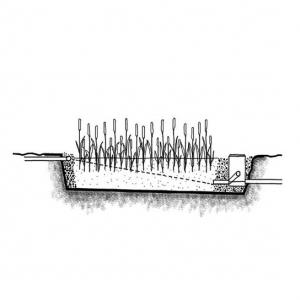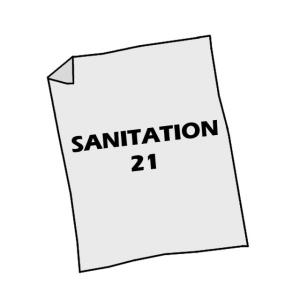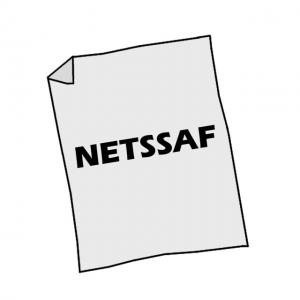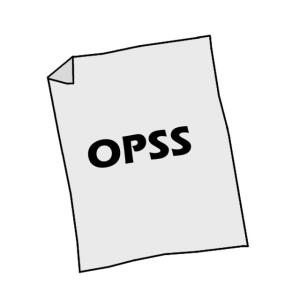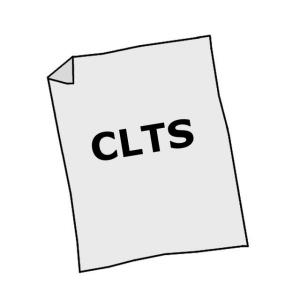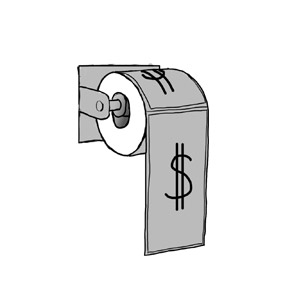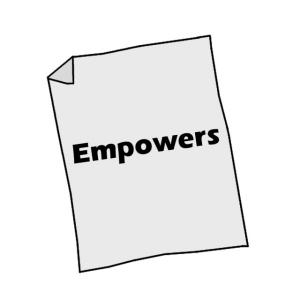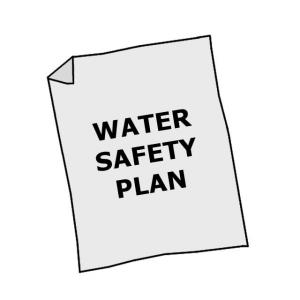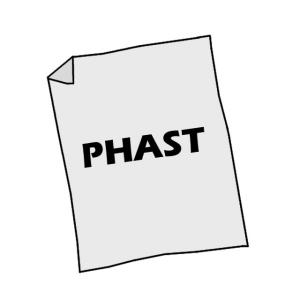Executive Summary
A horizontal subsurface flow constructed wetland (horizontal subsurface flow CW) is a large gravel and sand-filled basin that is planted with wetland vegetation. It is used for secondary or tertiary treatment of wastewater (e.g. greywater or blackwater). Solids are removed in a primery treatment (e.g. in a septic tank or imhoff tank). As wastewater flows horizontally through the basin, the filter material filters out particles and microorganisms degrade the organics. The effluent of a well-functioning constructed wetland can be used for irrigation and aquaculture or safely been discharged to receiving water bodies. Design and implementation requires expert knowledge. Horizontal flow CW are relatively inexpensive to build where land is affordable and can be maintained by the local community as no high-tech spare parts, electrical energy or chemicals are required.
| In | Out |
|---|---|
Fertigation Water, Treated Water |
Introduction
Constructed wetlands are secondary treatment facilities for household (blackwater or greywater, in some cases also brownwater) and/or biodegradable municipal or industrial wastewater. Constructed wetlands are a treatment step of DEWATS systems and they can even be used as a tertiary treatment system for polishing after activated sludge or trickling filter plants (HOFFMANN et al. 2010).
The filter media acts as a filter for removing remaining solids, a fixed surface upon which bacteria can attach, and a base for the vegetation. Although facultative and anaerobic bacteria degrade most organics, the vegetation transfers a small amount of oxygen to the root zone so that aerobic bacteria can colonize the area and degrade organics as well. The plant roots play an important role in maintaining the permeability of the filter.
The plants grown in the wetland may be used for composting or biogas production (see also composting small scale, composting large scale or anaerobic digestion). Effluents, if they correspond to the WHO guidelines (see also WHO 2006: Guidelines for the safe use of wastewater excreta and greywater Volume I, Volume II, Volume III and Volume IV) may be used for fertigation.
Besides horizontal subsurface flow constructed wetlands there are two other types of constructed wetlands (CWs). They are classified according to the water flow regime as:
The three types of CWs may be combined with each other in hybrid constructed wetlands in order to exploit the specific advantages of the different systems.
One of the main advantages of CWs is that they are natural systems and thus not require chemicals, energy or high-tech infrastructure. Moreover, they are suited to be combined with aquaculture or sustainable agriculture (irrigation).
Design Considerations
The design of a horizontal subsurface flow constructed wetland depends on the treatment target and the amount and quality of the influent. It includes decisions about the amount of parallel flow paths and compartmentation. The removal efficiency of the wetland is a function of the surface area (length multiplied by width), while the cross-sectional area (width multiplied by depth) determines the maximum possible flow. Generally, a surface area of about 5 to 10 m2 per person equivalent is required.
A horizontal subsurface flow constructed wetland is a large gravel and sand-filled channel that is planted with aquatic vegetation. As wastewater flows horizontally through the channel, the filter material filters out particles and microorganisms degrade organics.
The water level in a Horizontal Subsurface Flow Constructed Wetland is maintained at 5 to 15 cm below the surface to ensure subsurface flow (TILLEY et al 2008).
Pre- and primary treatment is essential to prevent clogging and ensure efficient treatment. This separates solid materials (e.g. faeces or kitchen slop) as well as grease or oil from the liquid. Depending on the situation, there are several possibilities such as grease trap, septic tanks, anaerobic baffled reactors, imhoff tanks, biogas settlers, UASB reactors, or compost filters (HOFFMANN et al. 2010). The influent can be aerated by an inlet cascade to support oxygen-dependent processes, such as BOD reduction and nitrification.
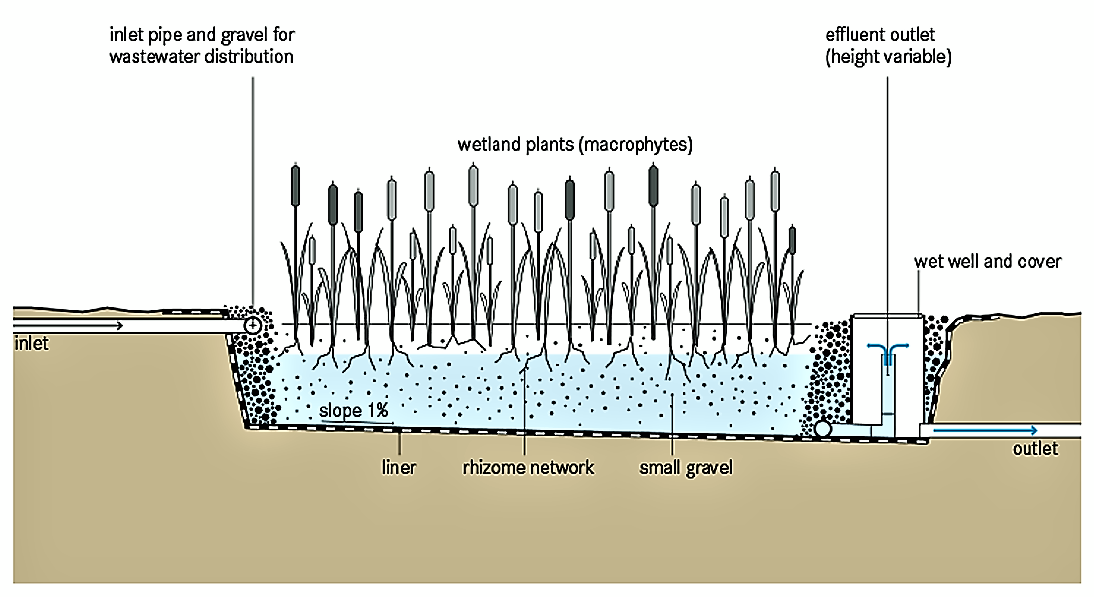
Pre-treated wastewater flows slowly through the porous medium under the surface of the bed in a horizontal path until it reaches the outlet zone. The bed should be lined with an impermeable liner (clay or geotextile) to prevent leaching. It should be wide and shallow so that the flow path of the water in contact with vegetation roots is maximized. A wide inlet zone should be used to evenly distribute the flow. A well-designed inlet that allows for even distribution is important to prevent short-circuiting. The outlet should be variable so that the water surface can be adjusted to optimize treatment performance.
At the outlet, the water level is controlled with an adjustable standpipe. A common design suggests a water level of about 60 cm which is maintained at ca. 5 to 15 cm below the surface of the CW to avoid anaerobic conditions in the bed. An important role of treatment efficiency is the oxygen supply. Horizontal filter beds have a very small external oxygen transfer and a smaller inlet compared to a vertical flow constructed wetland. Therefore they require a larger area.
Small, round, evenly sized gravel (3 to 32 mm in diameter) is most commonly used to fill the bed to a depth of 0.5 to 1 m. To limit clogging, the gravel should be clean and free of fines. Sand is also acceptable, but is more prone to clogging than gravel (EAWAG/SANDEC 2008) . The inlet and the outlet zone should be constructed with coarse gravel.
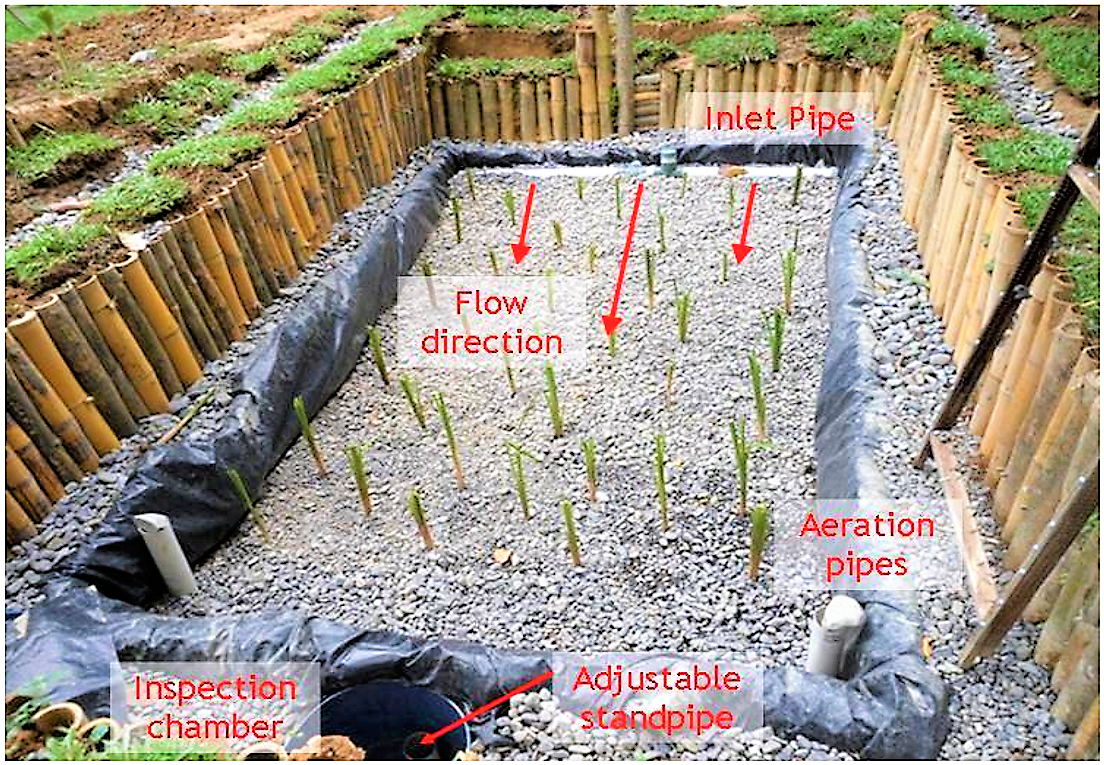
In recent years, alternative filter materials, such as PET, have been successfully used. The water level in the wetland is maintained at 5 to 15 cm below the surface to ensure subsurface flow (TILLEY et al 2008) .
If topography allows for gravity flow, horizontal flow filters are not dependent on energy and can be operated by gravity. For designing the filter bed, expert knowledge is required. Parameters such as hydraulic load or organic loading (e.g. BOD) (HOFFMANN 2010) and experience of the designer specify the size of the filter as well as the filter substrate (see also vertical CW).
Plants
In contrast to a non-planted filter, plants in constructed wetlands are an important part of the design. Plants are aesthetically pleasant and serve as a habitat for wildlife. Dead plant material is a natural insulation layer and protects the filter bed during winter in cold climates. Furthermore, the vegetation transfers oxygen to the filter zone and plants and its roots provide an appropriate habitat for microbiological growth in the root zone. But the most essential function of the vegetation, i.e. the roots system is to maintain the permeability in the filter (HOFFMANN et al. 2010 and TILLEY et al. 2008).
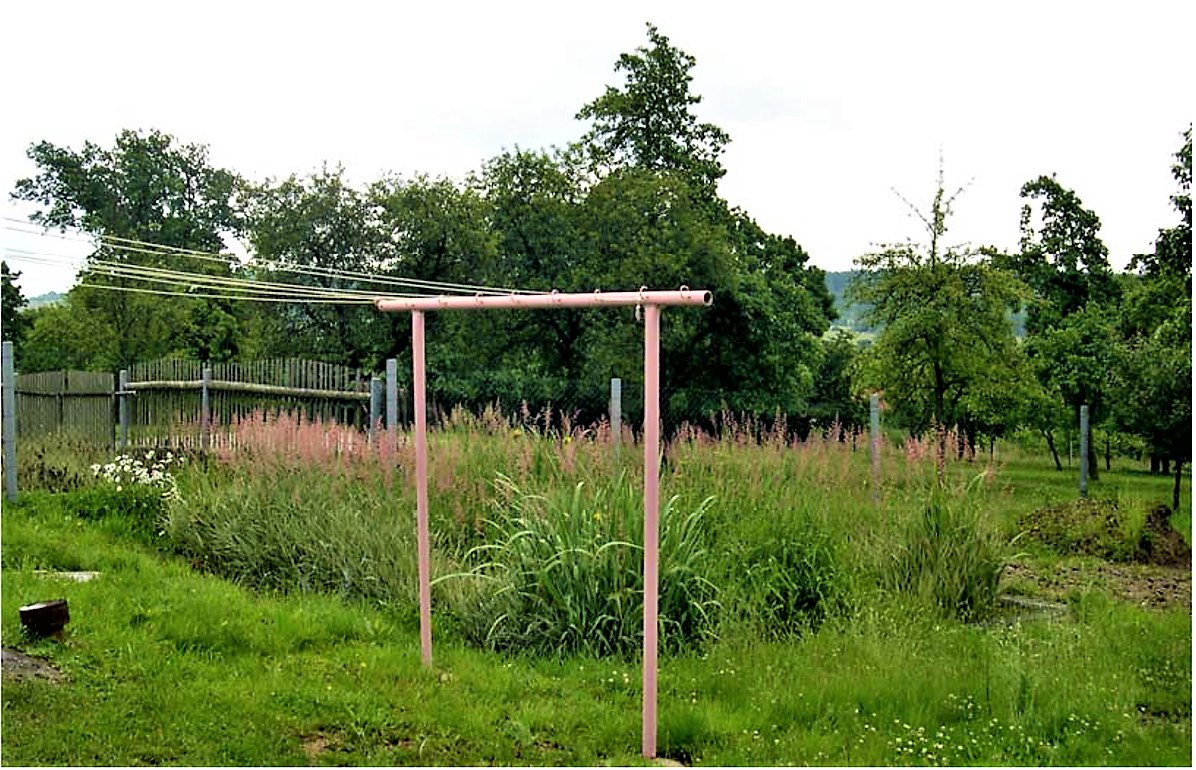
Any native plant with deep, wide roots that can grow in the wet, nutrient-rich environment is appropriate. Phragmites australis (reed) is a common choice because it forms horizontal rhizomes that penetrate the entire filter depth. The plant should build a deep root zone to transfer at least a minimum of oxygen into the filter body (TILLEY et al. 2008).
Bamboo or papyrus should also be possible, but that has not been investigated yet (HOFFMANN et al. 2010). Other suitable plants and their characteristics can be found in the document HOFFMANN et al. 2010 (see further readings below).
Health Aspects/Acceptance
Significant pathogen removal is accomplished by natural decay, predation by higher organisms, and filtration. In case of domestic wastewater disinfection (by tertiary treatment) might be necessary, depending on the intended reuse application (HOFFMANN et al. 2010). As the water flows below the surface, any contact of pathogenic organisms with humans and wildlife is minimized. The biggest health risk arises from settled wastewater in the pre-treatment facility. A proper emptying process (human powered or motorised) can decrease the health risks (TILLEY et al. 2008). After that, also sludge must be treated correctly, for example in drying beds or composting facilities. The risk of mosquito breeding is reduced since there is no standing water compared to the risk associated with Free-Water Surface Constructed Wetlands. The wetland is aesthetically pleasing and can be integrated into wild areas or parklands.
Costs Considerations
The capital costs of constructed wetlands are highly dependent on the costs of sand (since the bed has to be filled with sand), and on the cost of land (HOFFMANN et al. 2010). Financial decisions on treatment processes should not primarily be made on capital costs, but on net present value or whole-of-life costs, which includes the annual costs for operation and maintenance (HOFFMANN et al. 2010).
Compared to other intensive (high-rate) aerobic treatment options (e.g. activated sludge), constructed wetlands are natural systems, which work extensively. That means treatment may require more land and time, but costs can be safed because of lower operation, which requires no or only little electrical energy and operators can be trained people from the community (low-skilled people). Furthermore, there is no need for sophisticated equipment, expensive spare parts or chemicals (GAUSS 2008). According to HOFFMANN et al. (2010), constructed wetlands are usually cheaper to build than high-rate aerobic plants but for larger plants, they are usually more expensive in terms of capital costs.
For large-scale treatment plants of more than 10 000 PE in areas where land is available cheaply, free-surface-flow constructed wetlands and waste stabilisation ponds have lower capital costs than subsurface-flow constructed wetlands (horizontal and vertical) due to the high amounts of sand and gravel fill required for the bed of the sub-surface flow constructed wetland. Plants and liners may substantially add to the costs if they are unavailable locally (EAWAG/SANDEC 2008). Moreover, design and construction of subsurface-flow constructed wetland requires skilled technical staff. However, the cost may be reduced if the material is acquired locally.
Operation & Maintenance
In general the O&M requirements for constructed wetlands are relatively simple (no high-tech appliances or chemical additives), which may allow a community organisation or a private, small-scale entrepreneur to manage the system after adequate capacity building and with technical support (GAUSS 2008). However, a CW will always require some maintenance for the duration of its life. This aspect is frequently overlooked in decision-making processes.
During the first growing season, it is important to remove weeds that can compete with the planted wetland vegetation. With time, the gravel will become clogged with accumulated solids and bacterial film. The filter material at the inlet zone will require replacement every 10 or more years. Maintenance activities should focus on ensuring that primary treatment is effective at reducing the concentration of solids in the wastewater before it enters the wetland (TILLEY et al. 2008) . Maintenance should also ensure that trees do not grow in the area as the roots can harm the liner.
A very critical situation occurs, when the filter smells like “foul eggs”. This is an indicator for anaerobic conditions. In this case the filter should be rested and the loads must be readjusted (HOFFMANN et al. 2010). Pre-treatment facilities need to be checked regularly if they work properly and they have to be emptied frequently and sludge must be discharged correctly (see human-powered emptying and transport and motorised emptying and transport).
At a Glance
| Working Principle | Pre-treated grey or blackwater flows continuously and horizontally through a planted filter bed. Plants provide appropriate environments for microbiological attachment, growths and transfer of oxygen to the root zone. Organic matter and suspended solids are removed by filtration and microbiological degradation in aerobic anoxic and anaerobic conditions (MOREL and DIENER 2006). |
| Capacity/Adequacy | It can be applied for single households or small communities as a secondary or tertiary treatment facility of grey- or blackwater. Effluent can be reused for irrigation or is discharged into surface water (MOREL and DIENER 2006). |
| Performance | BOD = 80 to 90 %; TSS = 80 to 95 %; TN = 15 to 40 %; TP = 30 to 45 %; FC ≤ 2 to 3 log; LAS > 90 % |
| Costs | The capital costs of constructed wetlands are dependent on the costs of sand and gravel and also on the cost of land required for the CW. The operation and maintenance costs are very low (MOREL and DIENER 2006). |
| Self-help Compatibility | O&M by trained labourers, most of construction material locally available, except filter substrate could be a problem. Construction needs expert design. |
| O&M | Emptying of pre-settled sludge, removal of unwanted vegetation, cleaning of inlet/outlet systems. |
| Reliability | Clogging of the filter bed is the main risk of this system, but treatment performance is satisfactory. |
| Main strength | Efficient removal of suspended and dissolved organic matter, nutrients and pathogens; no wastewater above ground level and therefore no odour nuisance; plants have a landscaping and ornamental purpose (MOREL and DIENER 2006). |
| Main weakness | Permanent space required; risk of clogging if wastewater is not well pre-treated, high quality filter material is not always available and expensive; expertise required for design, construction and monitoring (MOREL and DIENER 2006). |
Clogging is a common problem and, therefore, the influent should be well settled with primary treatment before flowing into the wetland. This technology is not appropriate for untreated domestic wastewater (i.e. blackwater). It is a good treatment for communities that have primary treatment (e.g., Septic Tanks , anaerobic baffled reactors, imhoff tanks, biogas settlers, UASB reactors, or compost filters ) , but are looking to achieve a higher quality effluent (e.g. a constructed wetland combined with a solids-free sewer system) .
The horizontal subsurface flow constructed wetland is a good option where land is cheap and available. Depending on the volume of the water and the corresponding area requirement of the wetland, it can be appropriate for small sections of urban areas, as well as for peri-urban and rural communities. It can also be designed for single households.
Constructed wetlands are natural systems and do not require electrical energy (unless for pumps), nor chemicals, although the wetland will require some maintenance for the duration of its life. Where land is cheap and available, it is a good option as long as the community is organised enough to thoroughly plan and maintain the wetland for the duration of its life.
This technology is best suited for warm climates, but it can be designed to tolerate some freezing and periods of low biological activity. Shade from plants and protection from wind mixing is limiting the dissolved oxygen in the water. If the effluent is to be reused, the losses due to high evapotranspiration rates could be a drawback of this technology, depending on the climate.
Constructed wetlands allow for the combination with aquaculture and agriculture (irrigation). This contributes to the optimisation of the local water and nutrient cycle.
Small and Decentralized Wastewater Management Systems
Decentralised wastewater management presents a comprehensive approach to the design of both conventional and innovative systems for the treatment and disposal of wastewater or the reuse of treaded effluent. Smaller treatment plants, which are the concern of most new engineers, are the primary focus of this book.
CRITES, R. TCHOBANOGLOUS, G. (1998): Small and Decentralized Wastewater Management Systems. New York: The McGraw-Hill Companies IncSanitation Systems and Technologies. Lecture Notes
Lecture notes on technical and non-technical aspects of sanitation systems in developing countries.
EAWAG/SANDEC (2008): Sanitation Systems and Technologies. Lecture Notes . (= Sandec Training Tool 1.0, Module 4 ). Duebendorf: Swiss Federal Institute of Aquatic Science (EAWAG), Department of Water and Sanitation in Developing Countries (SANDEC)Constructed Wetlands: A Promising Wastewater Treatment system for Small Localities. Experiences from Latin America
This report provides an overview of how constructed wetlands serve as natural wastewater treatment systems. It focuses especially on the subsurface horizontal flow type—a technology that has high potential for small and medium-size communities because of its simplicity, performance reliability, and low operation and maintenance requirements. The ability of this wetland to reduce pathogens renders the effluent suitable for irrigation of certain crop species if additional health and environmental protection measures are taken. This report describes several experiences with constructed wetland schemes in Central and South America: a full-scale pilot plant in Nicaragua, a community-managed constructed wetland scheme in El Salvador, and other systems in Colombia, Brazil, and Peru.
GAUSS, M. WSP (2008): Constructed Wetlands: A Promising Wastewater Treatment system for Small Localities. Experiences from Latin America. Washington D.C.: The World Bank URL [Accessed: 12.12.2011]Technology Review of Constructed Wetlands
This publication intends to help spread awareness and knowledge about the technology of subsurface flow constructed wetlands in developing countries. Constructed wetlands (CWs) can be used as part of decentralised wastewater treatment systems, due to their “robust”, “low-tech” nature with none or few moving parts (pumps) and relatively low operational requirements. CWs can be used for the treatment of domestic and municipal wastewater or greywater, and play an important role in many ecological sanitation (ecosan) concepts.
HOFFMANN, H. PLATZER, C. WINKER, M. MUENCH, E. von GIZ (2011): Technology Review of Constructed Wetlands. Subsurface Flow Constructed Wetlands for Greywater and Domestic Wastewater Treatment. Eschborn: Deutsche Gesellschaft fuer Internationale Zusammenarbeit (GIZ) GmbH URL [Accessed: 01.06.2019]Treatment Wetlands. 2nd Edition
This book supports in making informed decisions regarding wetland design.
KADLEC, R. H. WALLACE, S. D. (2009): Treatment Wetlands. 2nd Edition. Boca Raton: CRC Press, Taylor & Francis Group URL [Accessed: 09.06.2019]Greywater Management in Low and Middle-Income Countries, Review of Different Treatment Systems for Households or Neighbourhoods
This report compiles international experience in greywater management on household and neighbourhood level in low and middle-income countries. The documented systems, which vary significantly in terms of complexity, performance and costs, range from simple systems for single-house applications (e.g. local infiltration or garden irrigation) to rather complex treatment trains for neighbourhoods (e.g. series of vertical and horizontal-flow planted soil filters).
MOREL, A. DIENER, S. (2006): Greywater Management in Low and Middle-Income Countries, Review of Different Treatment Systems for Households or Neighbourhoods. (= SANDEC Report No. 14/06 ). Duebendorf: Swiss Federal Institute of Aquatic Science (EAWAG), Department of Water and Sanitation in Developing Countries (SANDEC) URL [Accessed: 27.05.2019]Compendium of Sanitation Systems and Technologies. 2nd Revised Edition
This compendium gives a systematic overview on different sanitation systems and technologies and describes a wide range of available low-cost sanitation technologies.
TILLEY, E., ULRICH L., LÜTHI, C., REYMOND P. and ZURBRÜGG C. (2014): Compendium of Sanitation Systems and Technologies. 2nd Revised Edition. Duebendorf, Switzerland: Swiss Federal Institute of Aquatic Science and Technology (Eawag) URL [Accessed: 03.05.2023] PDFCompendium of Sanitation Systems and Technologies
This compendium gives a systematic overview on different sanitation systems and technologies and describes a wide range of available low-cost sanitation technologies.
TILLEY, E., LUETHI, C., MOREL, A., ZURBRUEGG, C. and SCHERTENLEIB, R. (2008): Compendium of Sanitation Systems and Technologies. Duebendorf, Switzerland: Swiss Federal Institute of Aquatic Science and Technology (EAWAG) and Water Supply and Sanitation Collaborative Council (WSSCC) URL [Accessed: 15.02.2010] PDFConstructed Wetlands Manual
This manual has been prepared as a general guide to the design, construction, operation and maintenance of constructed wetlands for the treatment of domestic wastewater as well as introduction to the design of constructed wetland for sludge drying.
UN-HABITAT (2008): Constructed Wetlands Manual. Kathmandu: UN-HABITAT, Water for Asian Cities Program URL [Accessed: 15.02.2012]Manual – Constructed Wetlands Treatment of Municipal Wastewater
This manual discusses the capabilities of constructed wetlands, a functional design approach, and the management requirements to achieve the designed purpose. The manual also attempts to put the proper perspective on the appropriate use, design and performance of constructed wetlands. Furthermore, the document contains two case studies.
U.S. EPA (1999): Manual – Constructed Wetlands Treatment of Municipal Wastewater. Washington D.C.: United States: Environmental Protection Agency (EPA) URL [Accessed: 09.06.2019]Constructed Wetlands for Wastewater Treatment
This document explains how constructed wetlands work and there is a collection of different wetlands all over the world.
VYMAZAL, J. (2010): Constructed Wetlands for Wastewater Treatment. Prague: Department of Landscape Ecology URL [Accessed: 17.08.2011]Compendium of Sanitation Systems and Technologies (Arabic)
This is the Arabic version of the Compendium of Sanitation Systems and Technologies. The Compendium gives a systematic overview on different sanitation systems and technologies and describes a wide range of available low-cost sanitation technologies.
TILLEY, E. ULRICH, L. LUETHI, C. REYMOND, P. SCHERTENLEIB, R. ZURBRUEGG, C. (2014): Compendium of Sanitation Systems and Technologies (Arabic). 2nd Revised Edition. Duebendorf, Switzerland: Swiss Federal Institute of Aquatic Science and Technology (Eawag) PDFSmall and Decentralized Wastewater Management Systems
Decentralised wastewater management presents a comprehensive approach to the design of both conventional and innovative systems for the treatment and disposal of wastewater or the reuse of treaded effluent. Smaller treatment plants, which are the concern of most new engineers, are the primary focus of this book.
CRITES, R. TCHOBANOGLOUS, G. (1998): Small and Decentralized Wastewater Management Systems. New York: The McGraw-Hill Companies IncSanitation Systems and Technologies. Lecture Notes
Lecture notes on technical and non-technical aspects of sanitation systems in developing countries.
EAWAG/SANDEC (2008): Sanitation Systems and Technologies. Lecture Notes . (= Sandec Training Tool 1.0, Module 4 ). Duebendorf: Swiss Federal Institute of Aquatic Science (EAWAG), Department of Water and Sanitation in Developing Countries (SANDEC)Decentralised Wastewater Management Using Constructed Wetlands
This paper describes the importance of small-scale decentralised wastewater treatment using reed bed treatment systems (constructed wetlands) in Nepal. It shows how public/community participation can support small-scale construction work while ensuring checks on quality and price of construction, including examples.
ENPHO (n.y): Decentralised Wastewater Management Using Constructed Wetlands. Kathmandu: Environment and Public Health Organization (ENPHO) URL [Accessed: 10.06.2019]Technology Review of Constructed Wetlands
This publication intends to help spread awareness and knowledge about the technology of subsurface flow constructed wetlands in developing countries. Constructed wetlands (CWs) can be used as part of decentralised wastewater treatment systems, due to their “robust”, “low-tech” nature with none or few moving parts (pumps) and relatively low operational requirements. CWs can be used for the treatment of domestic and municipal wastewater or greywater, and play an important role in many ecological sanitation (ecosan) concepts.
HOFFMANN, H. PLATZER, C. WINKER, M. MUENCH, E. von GIZ (2011): Technology Review of Constructed Wetlands. Subsurface Flow Constructed Wetlands for Greywater and Domestic Wastewater Treatment. Eschborn: Deutsche Gesellschaft fuer Internationale Zusammenarbeit (GIZ) GmbH URL [Accessed: 01.06.2019]Treatment Wetlands. 2nd Edition
This book supports in making informed decisions regarding wetland design.
KADLEC, R. H. WALLACE, S. D. (2009): Treatment Wetlands. 2nd Edition. Boca Raton: CRC Press, Taylor & Francis Group URL [Accessed: 09.06.2019]Constructed Wetlands – Treating Wastewater with Cenoses of Plants and Microorganisms
The underlying philosophy of phytoremediation research at UFZ (Centre for Environmental Research) is to exploit and to optimise the processes in the rhizosphere. Low-cost, simple systems will be developed to control the environmental problems of different countries in several continents irrespective of their industrial capabilities and conditions – without losing sight of the key principle of cleaning up polluted environmental media in a natural, ecologically balanced way.
KUSCHK, P. WIESSNER, A. MUELLER, R. KAESTNER, M. (2005): Constructed Wetlands – Treating Wastewater with Cenoses of Plants and Microorganisms. Leipzig-Halle: UFZ Centre for Environmental Research URL [Accessed: 10.06.2019]Greywater Management in Low and Middle-Income Countries, Review of Different Treatment Systems for Households or Neighbourhoods
This report compiles international experience in greywater management on household and neighbourhood level in low and middle-income countries. The documented systems, which vary significantly in terms of complexity, performance and costs, range from simple systems for single-house applications (e.g. local infiltration or garden irrigation) to rather complex treatment trains for neighbourhoods (e.g. series of vertical and horizontal-flow planted soil filters).
MOREL, A. DIENER, S. (2006): Greywater Management in Low and Middle-Income Countries, Review of Different Treatment Systems for Households or Neighbourhoods. (= SANDEC Report No. 14/06 ). Duebendorf: Swiss Federal Institute of Aquatic Science (EAWAG), Department of Water and Sanitation in Developing Countries (SANDEC) URL [Accessed: 27.05.2019]Ecodesign: The Bottom Line
There is no single design solution to sanitation. But there are universal principles for systematically and safely detoxifying human excreta, without contaminating, wasting or even using water. Ecological sanitation design — which is focused on sustainability through reuse and recycling — offers workable solutions that are gaining footholds around the world, as Nature explores on the following pages through the work of Peter Morgan in Zimbabwe, Ralf Otterpohl and his team in Germany, Shunmuga Paramasivan in India, and Ed Harrington and his colleagues in California.
NATURE (Editor) ; MORGAN, P. ; OTTERPOHL, R. ; PARAMASIVAN, S. ; HARRINGTON, E. (2012): Ecodesign: The Bottom Line. In: Nature: International Weekly Journal of Science: Volume 486 , 186-189. URL [Accessed: 19.06.2012]DEWATS
Exhaustive report on technological, operational and economic aspects of decentralised waste water treatment systems. Spreadsheet examples support the reader in designing and planning waste water treatment systems components.
SASSE, L. BORDA (1998): DEWATS. Decentralised Wastewater Treatment in Developing Countries. Bremen: Bremen Overseas Research and Development Association (BORDA) URL [Accessed: 03.06.2019]FS Management – Review of Practices, Problems and Initiatives
A study on management and institutional aspects regarding the challenges and possible improvements in managing faecal sludge.
STRAUSS, M. MONTANGERO, A. (2002): FS Management – Review of Practices, Problems and Initiatives. London and Duebendorf: DFID Project R8056, Capacity Building for Effective Decentralised Wastewater Management, Swiss Federal Institute of Aquatic Science (EAWAG), Department of Water and Sanitation in Developing Countries (SANDEC) URL [Accessed: 28.05.2019]Compendium of Sanitation Systems and Technologies. 2nd Revised Edition
This compendium gives a systematic overview on different sanitation systems and technologies and describes a wide range of available low-cost sanitation technologies.
TILLEY, E., ULRICH L., LÜTHI, C., REYMOND P. and ZURBRÜGG C. (2014): Compendium of Sanitation Systems and Technologies. 2nd Revised Edition. Duebendorf, Switzerland: Swiss Federal Institute of Aquatic Science and Technology (Eawag) URL [Accessed: 03.05.2023] PDFWaste Stabilization Ponds and Constructed Wetlands Manual.
Design manual for designers, builders and operators on the design and operation of artificially constructed wetlands and waste stabilization ponds. The supporting information includes a standard systems approach which can be adopted universally; the theoretical background on the biological, chemical and physical processes of each method, the current state of the technology and technical knowledge on how to design, operate and maintain them; and theoretical knowledge on how best the models may be used to describe the systems.
UNEP (n.y): Waste Stabilization Ponds and Constructed Wetlands Manual. . United Nations Environmental Programme International Environmental Technology Center (UNEP-IETC) and the Danish International Development Agency (Danida) URL [Accessed: 19.04.2010]Constructed Wetlands for Wastewater Treatment
This document explains how constructed wetlands work and there is a collection of different wetlands all over the world.
VYMAZAL, J. (2010): Constructed Wetlands for Wastewater Treatment. Prague: Department of Landscape Ecology URL [Accessed: 17.08.2011]Guidelines for the safe use of wastewater excreta and greywater. Volume IV. Excreta and Greywater Use in Agriculture
Volume IV of the Guidelines for the Safe Use of Wastewater, Excreta and Greywater recognizes the reuse potential of wastewater and excreta (including urine) in agriculture and describes the present state of knowledge as regards potential health risks associated with the reuse as well as measures to manage these health risks following a multi-barrier approach.
WHO (2006): Guidelines for the safe use of wastewater excreta and greywater. Volume IV. Excreta and Greywater Use in Agriculture. Geneva: World Health Organisation (WHO) URL [Accessed: 09.05.2019] PDFTechnology Options for Urban Sanitation in India. A Guide to Decision-Making
These guidance notes are designed to provide state governments and urban local bodies with additional information on available technologies on sanitation. The notes also aid in making an informed choice and explain the suitability of approaches.
WSP (2008): Technology Options for Urban Sanitation in India. A Guide to Decision-Making. pdf presentation. New Delhi: Water and Sanitation Program (WSP) URL [Accessed: 03.06.2019]Decentralised Wastewater Management Using Constructed Wetlands
This paper describes the importance of small-scale decentralised wastewater treatment using reed bed treatment systems (constructed wetlands) in Nepal. It shows how public/community participation can support small-scale construction work while ensuring checks on quality and price of construction, including examples.
ENPHO (n.y): Decentralised Wastewater Management Using Constructed Wetlands. Kathmandu: Environment and Public Health Organization (ENPHO) URL [Accessed: 10.06.2019]Constructed Wetlands: A Promising Wastewater Treatment system for Small Localities. Experiences from Latin America
This report provides an overview of how constructed wetlands serve as natural wastewater treatment systems. It focuses especially on the subsurface horizontal flow type—a technology that has high potential for small and medium-size communities because of its simplicity, performance reliability, and low operation and maintenance requirements. The ability of this wetland to reduce pathogens renders the effluent suitable for irrigation of certain crop species if additional health and environmental protection measures are taken. This report describes several experiences with constructed wetland schemes in Central and South America: a full-scale pilot plant in Nicaragua, a community-managed constructed wetland scheme in El Salvador, and other systems in Colombia, Brazil, and Peru.
GAUSS, M. WSP (2008): Constructed Wetlands: A Promising Wastewater Treatment system for Small Localities. Experiences from Latin America. Washington D.C.: The World Bank URL [Accessed: 12.12.2011]Wastewater treatment using constructed wetlands Tirana, Albania - draft
Within the BMZ (German Federal Ministry for Economic Cooperation and Development) financed project on “Advice on the Decentralisation of the Water and Sewerage Sector in Albania” the GIZ and MPWT (Albanian Ministry of Public Works and Transport) initiated the pilot constructed wetland to raise awareness for low cost, appropriate and decentralised sanitation technologies in line with EU standards. It is aimed to be used as a model treatment plant by the main actors of the sector for training, demonstration, research and replication in peri-urban and rural areas of Albania.
GJINALI, E. NIKLAS, J. (2009): Wastewater treatment using constructed wetlands Tirana, Albania - draft. (= SuSanA - Case Studies ). Eschborn: Sustainable Sanitation Alliance (SuSanA) URL [Accessed: 10.06.2019]Constructed Wetland for a Peri-urban Housing Area Bayawan City, Philippines
Case study on constructed wetlands for a peri-urban housing area. Septic tanks are used to pre-treat the sewage. The pre-treated wastewater is transported through a small-bore sewer system.
LIPKOW, U. MUENCH, E. von (2010): Constructed Wetland for a Peri-urban Housing Area Bayawan City, Philippines. (= SuSanA – Case Studies ). Eschborn: Sustainable Sanitation Alliance (SuSanA) URL [Accessed: 10.06.2019]Selected contributions from the 1st WATERBIOTECH conference, 9-11 October 2012, Cairo, Egypt
This issue publishes selected contributions from the 1st WATERBIOTECH conference. WATERBIOTECH („Biotechnology for Africa‘s sustainable water supply“) is a coordination and support action funded within the Africa call of the EU 7th Framework Programme.
ECOSAN CLUB (2013): Selected contributions from the 1st WATERBIOTECH conference, 9-11 October 2012, Cairo, Egypt. (= Sustainable Sanitation Pratice , 14 ). Vienna: Ecosan Club URL [Accessed: 29.01.2013]Constructed Wetlands: Passive Systems for Wastewater Treatment
This report summarises the role of constructed wetlands to remove contaminants from wastewater, and profiles several sites where constructed wetlands have been implemented for treatment applications other than municipal wastewater. It contains information gathered from a range of currently available sources, including project documents, reports, periodicals, Internet searches, and personal communication with involved parties.
LORION, R. (2001): Constructed Wetlands: Passive Systems for Wastewater Treatment. Washington DC: Environmental Protection Agency (EPA) URL [Accessed: 17.08.2011]UDD Toilets at a Rural Secondary School Kalunga, Uganda
Case study on a school UDDT project and the reuse of the collected urine in Kalunga, Uganda
MUELLEGGER, E. SuSanA (2009): UDD Toilets at a Rural Secondary School Kalunga, Uganda. (= SuSanA case study ). Sustainable Sanitation Alliance URL [Accessed: 12.12.2012]Opportunities in Fecal Sludge Management for Cities in Developing Countries: Experiences from the Philippines
In July 2012, a team from RTI International deployed to the Philippines to evaluate four FSM programs with the goal of reporting on best practices and lessons learned. The four cases—Dumaguete City, San Fernando City, Maynilad Water for the west zone of metro Manila, and Manila Water from the east zone of metro Manila—were chosen to highlight their different approaches to implementing FSM.
ROBBINS, D. STRANDE, L. DOCZI, J. (2012): Opportunities in Fecal Sludge Management for Cities in Developing Countries: Experiences from the Philippines. North Carolina: RTI International URL [Accessed: 10.06.2019]Constructed Wetlands for Wastewater Treatment and Wildlife Habitat
This document provides brief descriptions of 17 wetland treatment systems from that are providing significant water quality benefits while demonstrating additional benefits such as wildlife habitat. The projects described include systems involving both constructed and natural wetlands, habitat creation and restoration, and the improvement of municipal effluent, urban stormwater and river water quality. Each project description was developed by individuals directly involved with or very familiar with the project in a format that could also be used as a stand-alone brochure or handout for project visitors.
U.S. EPA (1993): Constructed Wetlands for Wastewater Treatment and Wildlife Habitat. Washington DC: Environmental Protection Agency (EPA) URL [Accessed: 10.06.2019]Decentralized Urban Greywater Treatment at Klosterenga Oslo
Today it is possible to foresee completely decentralized wastewater treatment systems in urban areas where the blackwater fractions (urine and faecal matter) is reclaimed for fertilizer and potentially energy production. The water from kitchen sinks and showers (greywater) is treated locally in compact low maintenance systems that constitute attractive landscape elements. These systems can coexist with decentralized water supply.
JENSSEN, P. (2005): Decentralized Urban Greywater Treatment at Klosterenga Oslo. In: Ecological Engineering-Bridging between Ecology and Civil Engineering: , 84-86. URL [Accessed: 21.02.2012]Treatment Wetlands
Issue 12 of Sustainable Sanitation Practice (SSP) on „Treatment wetlands“ includes 6 contributions: (1.) the Austrian experience with single-stage sand and gravel based vertical flow systems with intermittent loading (the Austrian type is for treating mechanically pre-treated wastewater), (2.) the French experiences with two-stage vertical flow systems treating raw wastewater. (3.) EcoSan Club‘s experiences with TWs in Uganda, (4.) results from multi-stage TW treating raw wastewater in Morocco. (5.) results from horizontal flow experimental systems from Egypt, and (6.) experiences from Denmark and UK on reed beds treating excess sludge from activated sludge plants.
MUELLEGGER, E. ; LANGERGRABER, G. ; LECHNER, M. (2012): Treatment Wetlands. (= Sustainable Sanitation Practice , 12 ). Vienna: EcoSan Club URL [Accessed: 18.07.2012]Greywater
This Sustainable Sanitation Practice (SSP) issue contains the following contributions: 1. Combined Greywater Reuse and Rainwater Harvesting in an Office Building - Austria, 2. Household Greywater Treatment for Peri-Urban Areas - Kenya, 3. Greywater Use in Peri-Urban Households - Uganda, 4. Greywater Treatment in Apartment Building - Austria, 5. Combined Greywater Treatment Using a Membrane Bioreactor.
MUELLEGGER, E. ; LANGEGRABER, G. ; LECHNER, M. (2009): Greywater . Treatment and Reuse. (= Sustainable Sanitation Practice , 1 ). Vienna: Ecosan Club URL [Accessed: 01.07.2013] PDFSanitation Systems and Technologies. Presentation
PDF presentation on the technical and non-technical aspects of sanitation systems in developing countries.
EAWAG/SANDEC (2008): Sanitation Systems and Technologies. Presentation. (= Sandec Training Tool 1.0, Module 4 ). Duebendorf: Swiss Federal Institute of Aquatic Science (Eawag), Department of Water and Sanitation in Developing Countries (Sandec)Constructed Wetlands Manual
This manual has been prepared as a general guide to the design, construction, operation and maintenance of constructed wetlands for the treatment of domestic wastewater as well as introduction to the design of constructed wetland for sludge drying.
UN-HABITAT (2008): Constructed Wetlands Manual. Kathmandu: UN-HABITAT, Water for Asian Cities Program URL [Accessed: 15.02.2012]Manual – Constructed Wetlands Treatment of Municipal Wastewater
This manual discusses the capabilities of constructed wetlands, a functional design approach, and the management requirements to achieve the designed purpose. The manual also attempts to put the proper perspective on the appropriate use, design and performance of constructed wetlands. Furthermore, the document contains two case studies.
U.S. EPA (1999): Manual – Constructed Wetlands Treatment of Municipal Wastewater. Washington D.C.: United States: Environmental Protection Agency (EPA) URL [Accessed: 09.06.2019]Small-scale Constructed Wetlands for Greywater and Total Domestic Wastewater Treatment
This training material quantifies and characterises grey- and total domestic wastewater production and exemplifies designing of small-scale horizontal and vertical flow constructed wetland system.
WAFLER, M. (2008): Small-scale Constructed Wetlands for Greywater and Total Domestic Wastewater Treatment. Vienna: seecon international gmbhTechnical Lecture Greywater Management
Healthy Wetlands, Healthy People: A Review of Wetlands and Human Health Interactions
Despite the production of more food and extraction of more water globally, wetlands continue to decline and public health and living standards for many do not improve. Why is this – and what needs to change to improve the situation? If we manage wetlands better, can we improve the health and well-being of people? Indeed, why is this important? This report seeks to address these questions.
HORWITZ, P. FINLAYSON, M. WEINSTEIN, P. (2012): Healthy Wetlands, Healthy People: A Review of Wetlands and Human Health Interactions. Ramsar Technical Report No. 6. Gland and Geneva: Secretariat of the Ramsar Convention on Wetlands and The World Health Organization (WHO) URL [Accessed: 10.06.2019]
